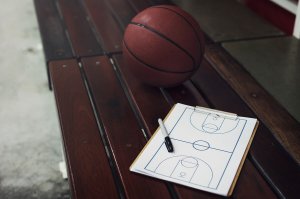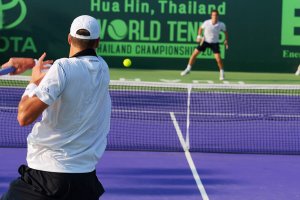Importance of Technique and Tactics in Sport

Technique and tactics are two central concepts for all sports practices. However, they’re often confused and end up losing their true meaning, as well as the vital importance they have for individual and collective performance. Next, we’ll delve into the basic characteristics of each one.
These are words that business or military also uses. Technique and tactics are two words the media often mentions too. However, this frequency doesn’t prevent their meanings from being interchanged or misinterpreted.
Technique and tactics: definitions
The first thing that we must consider is to have very clear limits between these two concepts. It’s important to note that, despite its core differences both concepts converge and mutually reinforce each other while practicing a sport. This is what we understand by technique and tactics in sports disciplines:
Technique
The technique is linked to the motor learning of each person; consists of the execution of movements and skills necessary for the realization of a sport. Unlike tactics, the technique does not take into account the adversary’s opposition factor.
On the contrary, it’s inherent to the athletes themselves. The technique only depends on athletes’ training and the way they’re able to distinguish themselves in the field.
Tactics
Tactics in sport can be individual or collective; in both cases, the opposition posed by the adversary is a necessary element to define it. Basically, tactics consist of planning strategies to implement during a match. Tactics happen in training or during the match, based on the individual technical conditions and the combination of group actions.
Every group or individual that competes in a sport discipline establishes a tactic in advance. Training is about polishing the tactics that will be implemented.

However, it’s also necessary to consider that tactics always demand a good observation, since the circumstances of a game can change. Many times, athletes will have to improvise in order to respond accordingly. Injuries, goals, expulsions and many other events can alter the development of competition.
Why are technique and tactics important in sport?
The technique is, in short, what makes an athlete good, regular, outstanding or excellent. It’s the ability to translate into concrete actions what a sport demands and what a coach recommends.
Therefore, it’s evident that it’s an indispensable component for sporting success. The purpose of the technique is to achieve the effectiveness to solve situations in the best possible way.
Meanwhile, the tactic is also central, since it aims to achieve good results in a competition. Tactics allow the athlete to score a goal, win a game and adapt to the circumstances of a particular time.
The tactics power the technique because it makes a player perform in the position that best suits him according to their physical characteristics. To demonstrate the validity of this statement, it’s enough to observe how, if the performance of a player decreases, the technical director will assign them to another position, or remove them from the field.
For example, in the case of soccer, this is often seen when the coach asks a defender to engage in offensive functions. While he can do well on specific plays, surely his lack of technique will be evident if he isn’t properly trained in these techniques.

Tactic and strategy are not the same
According to Sampedro (1999), the strategy is similar to the tactic in terms of advance planning but encompasses many aspects that exceed the immediacy of the competition.
For example, the strategy covers concepts such as training planning, feeding, the selection of athletes, etc. The objective pursued is broader, and more often than not it has a lot to do with sporting results, but also with enhancing the performance of an athlete or group.
Finally, we can distinguish different types of tactics: individual (one-on-one sports), collective, defensive, offensive, etc. The point is that all of them must contemplate the technical possibilities of their performers. Plus, tactics must provide athletes with resources to carry out the right decisions according to the circumstances.
Technique and tactics are two central concepts for all sports practices. However, they’re often confused and end up losing their true meaning, as well as the vital importance they have for individual and collective performance. Next, we’ll delve into the basic characteristics of each one.
These are words that business or military also uses. Technique and tactics are two words the media often mentions too. However, this frequency doesn’t prevent their meanings from being interchanged or misinterpreted.
Technique and tactics: definitions
The first thing that we must consider is to have very clear limits between these two concepts. It’s important to note that, despite its core differences both concepts converge and mutually reinforce each other while practicing a sport. This is what we understand by technique and tactics in sports disciplines:
Technique
The technique is linked to the motor learning of each person; consists of the execution of movements and skills necessary for the realization of a sport. Unlike tactics, the technique does not take into account the adversary’s opposition factor.
On the contrary, it’s inherent to the athletes themselves. The technique only depends on athletes’ training and the way they’re able to distinguish themselves in the field.
Tactics
Tactics in sport can be individual or collective; in both cases, the opposition posed by the adversary is a necessary element to define it. Basically, tactics consist of planning strategies to implement during a match. Tactics happen in training or during the match, based on the individual technical conditions and the combination of group actions.
Every group or individual that competes in a sport discipline establishes a tactic in advance. Training is about polishing the tactics that will be implemented.

However, it’s also necessary to consider that tactics always demand a good observation, since the circumstances of a game can change. Many times, athletes will have to improvise in order to respond accordingly. Injuries, goals, expulsions and many other events can alter the development of competition.
Why are technique and tactics important in sport?
The technique is, in short, what makes an athlete good, regular, outstanding or excellent. It’s the ability to translate into concrete actions what a sport demands and what a coach recommends.
Therefore, it’s evident that it’s an indispensable component for sporting success. The purpose of the technique is to achieve the effectiveness to solve situations in the best possible way.
Meanwhile, the tactic is also central, since it aims to achieve good results in a competition. Tactics allow the athlete to score a goal, win a game and adapt to the circumstances of a particular time.
The tactics power the technique because it makes a player perform in the position that best suits him according to their physical characteristics. To demonstrate the validity of this statement, it’s enough to observe how, if the performance of a player decreases, the technical director will assign them to another position, or remove them from the field.
For example, in the case of soccer, this is often seen when the coach asks a defender to engage in offensive functions. While he can do well on specific plays, surely his lack of technique will be evident if he isn’t properly trained in these techniques.

Tactic and strategy are not the same
According to Sampedro (1999), the strategy is similar to the tactic in terms of advance planning but encompasses many aspects that exceed the immediacy of the competition.
For example, the strategy covers concepts such as training planning, feeding, the selection of athletes, etc. The objective pursued is broader, and more often than not it has a lot to do with sporting results, but also with enhancing the performance of an athlete or group.
Finally, we can distinguish different types of tactics: individual (one-on-one sports), collective, defensive, offensive, etc. The point is that all of them must contemplate the technical possibilities of their performers. Plus, tactics must provide athletes with resources to carry out the right decisions according to the circumstances.
All cited sources were thoroughly reviewed by our team to ensure their quality, reliability, currency, and validity. The bibliography of this article was considered reliable and of academic or scientific accuracy.
- Joan Riera Riera. Estrategia, técnica y táctica deportivas. INEFC Barcelona. https://volley4all.files.wordpress.com/2015/10/039_045-056_es.pdf
- Javier Sampedro Molinuevo. Análisis de la estrategia de los deportes: concepto de técnica, táctica y estrategia. Universidad Politécnica de Madrid. http://ocw.upm.es/educacion-fisica-y-deportiva/analisis-de-la-estrategia-de-los-deportes/contenido/Tema_1/Tema_1_Estrategia.pdf
- Estrategia, táctica y técnica deportiva. 2013. Universidad Católica de San Antonio de Murcia. https://www.ucam.edu/sites/default/files/estudios/grados/cafd/71_4_47_opt_estrategia_tactica_y_tecnica_deportiva_71_4_47_opt_1_.pdf
- Fundamentos de la Táctica Deportiva. Análisis de la estrategia en los Deportes de Equipo.
Sampedro, J. Editorial Gymnos.1999
This text is provided for informational purposes only and does not replace consultation with a professional. If in doubt, consult your specialist.








